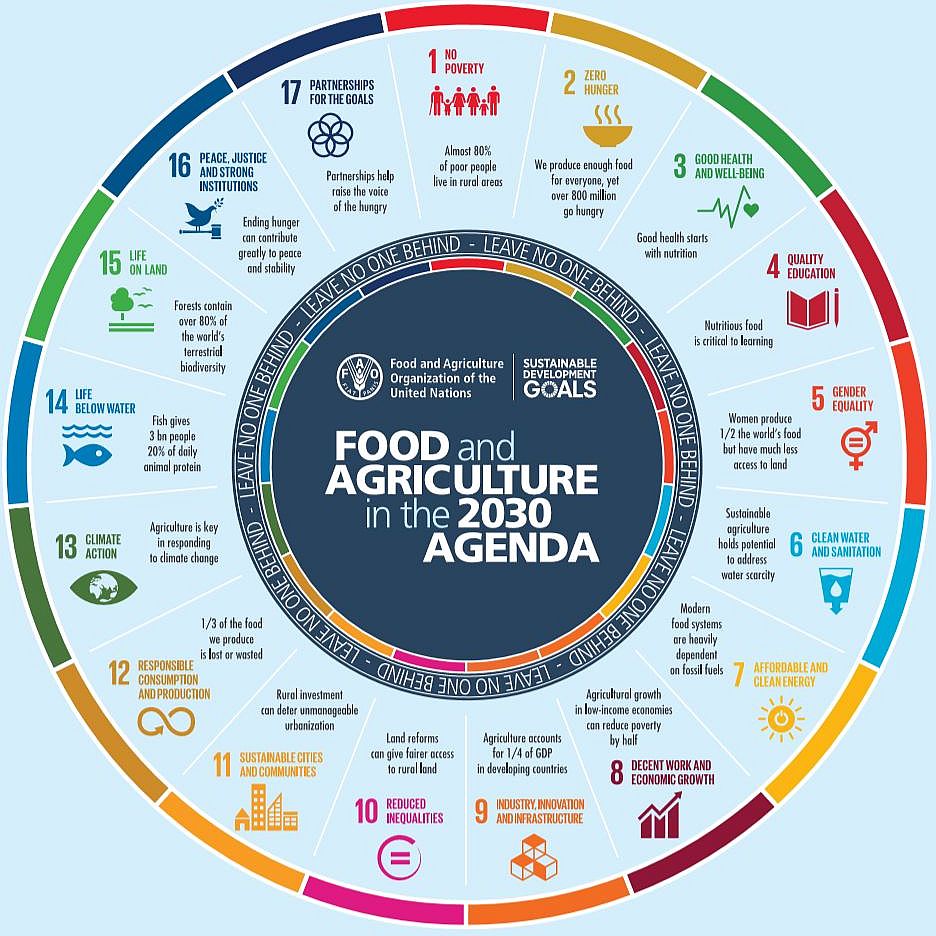Agenda 2030
Aktionsprogramm der Vereinten Nationen, das in einem mehr als drei Jahre dauernden, transparenten Verhandlungsprozess unter Einbeziehung der breiten Öffentlichkeit entwickelt wurde. Die Agenda ist Ausdruck einer neuen Qualität der Politik: Alles soll mit Bedacht auf eine nachhaltige Entwicklung überlegt und angegangen werden.
Im September 2015 haben die Staats- und Regierungschefsauf dem UN-Gipfel in New York nachhaltige Entwicklungsziele (Sustainable Development Goals, SDGs) verabschiedet. In der „Agenda 2030 für nachhaltige Entwicklung“ wurden damit erstmals wirtschaftliche, soziale und ökologische Entwicklungsziele verknüpft und Armutsbekämpfung und Nachhaltigkeit zusammengeführt. Die 17 Ziele der Agenda 2030 gehen weit über die Millenniumsentwicklungsziele, die Ende 2015 ausliefen, hinaus und richten sich gleichermaßen an alle Staaten der Weltgemeinschaft.
Die Agenda gilt - anders als frühere Programme zur nachhaltigen Entwicklung – gleichermaßen für Industrieländer, Schwellen- und Entwicklungsländer. Schließlich stehen alle in der Verantwortung, nachhaltige Entwicklung durch den grundlegenden Umbau von Strukturen, Prozessen sowie Denk- und Verhaltensweisen in den nächsten Jahren entscheidend voranzubringen.
Mit 17 Zielen und 169 Unterzielen ist die Agenda sehr umfangreich. Neben dem Kampf gegen den Hunger gehört natürlich der Kampf gegen Armut, gegen Diskriminierung von Frauen. Dazu gehört Bildung für alle, der Schutz des Klimas und der Biodiversität, mehr Engagement für Frieden und Rechtsstaatlichkeit, um nur ein paar Beispiele zu nennen.
Um die Agenda 2030 hierzulande umzusetzen, hat die Bundesregierung eine Deutsche Nachhaltigkeitsstrategie anhand dieser 17 Ziele und unter Einbeziehung wiederum der breiten Öffentlichkeit in einem Dialogverfahren erarbeitet und im Januar 2017 verabschiedet.
Food and agriculture in the 2030 Agenda for Sustainable Development
On 25 September 2015, the 193 Member States of the United Nations adopted the 2030 Agenda for Sustainable Development, including 17 Sustainable Development Goals (SDGs).a One lesson from the Millennium Development Goals (MDGs) is that it is no longer possible to look at food, livelihoods and the management of natural resources separately. The fundamental connection between people and the planet, sustainable food, and agriculture are at the heart of the 2030 Agenda. Tied to the principle of leaving no one behind, the broad priorities of FAO in the 2030 Agenda are to:
- end poverty, hunger and malnutrition;
- enable sustainable development in agriculture, fisheries and forestry;
- respond to climate change.
The comprehensive vision of SDG2, which is to “End hunger, achieve food security and improved nutrition and promote sustainable agriculture,” is mutually interlinked with several SDG targets, including those related to poverty eradication (SDG1), good health and well-being (SDG3), gender equality (SDG5), clean water and sanitation (SDG6), decent work and economic growth (SDG8), industry, innovation and infrastructure (SDG9), reduced inequalities (SDG10), responsible production and consumption (SDG12), climate action (SDG13), oceans and seas (SDG14), ecosystems, biodiversity and forests (SDG15), and peace, justice and strong institutions (SDG16). A significant factor in the success of the SDGs will be new and effective ways of collecting data, monitoring targets and measuring progress. FAO, together with its valued partners, is the “custodian” of several indicators related to undernourishment, rural income, sustainable agriculture, biodiversity, land and water use and ownership, as well as fisheries and forests (FAO, 2017b).
Sustainable Development Goals and food and agriculture
Quelle: FAO
Weitere Informationen:
- Nachhaltigkeitsindikatoren (Destatis)
- Monitoring der Agenda 2030 durch das Statistische Bundesamt (Destatis)
- Sustainable Development Goals (FAO)
- 17 Ziele für eine nachhaltige Zukunft (Welthungerhilfe)

